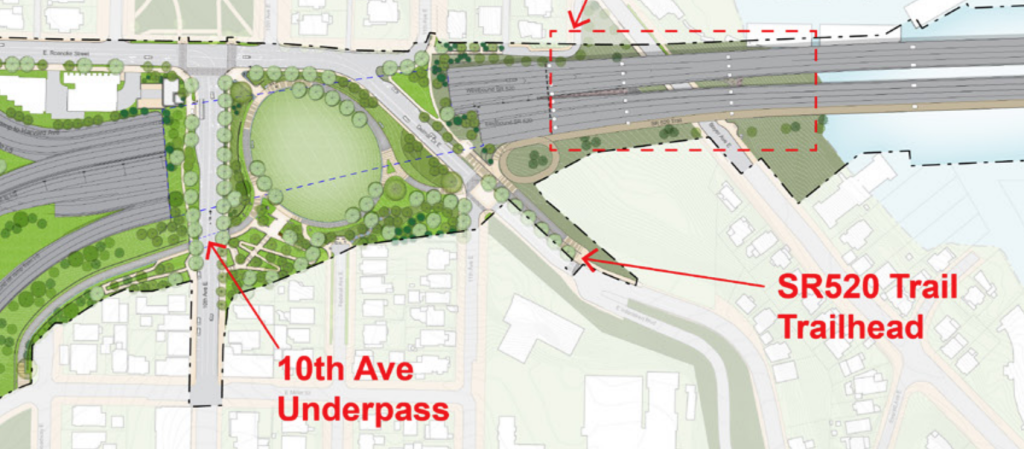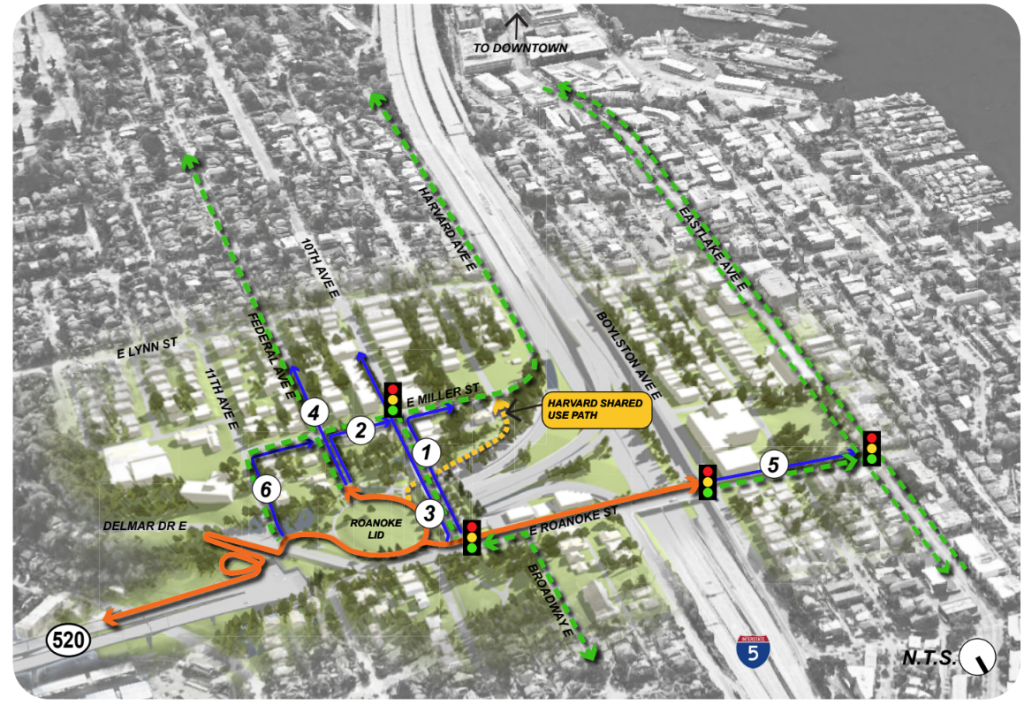The Washington Department of Transportation (WSDOT) has proposed to eliminate a long-planned trail tunnel from its designs for a highway lid in Seattle’s North Capitol Hill, eliminating a direct connection between the SR 520 multi-use path and the rest of the city’s bike and pedestrian network. The move comes after the state legislature asked WSDOT to look at scope changes to the megaproject, which also includes replacing two highway bridges over Portage Bay, to reduce the overall $1.38 billion dollar cost.
The tunnel would have connected people walking and biking on the new Roanoke Lid over 520 with the rest of the neighborhood underneath busy 10th Avenue E, providing a direct connection with Harvard Avenue E, a corridor regularly used by people on bikes to connect with the Lakeview Boulevard overpass over I-5 and Downtown Seattle beyond. It would have provided another way for people trying to access the planned 520 trail extension along the new Portage Bay bridge without conflicting with vehicle traffic at major intersections.

The push to reduce costs comes after the legislature scrambled to find additional funding to make up for cost increases on the project earlier this year. The initial transportation budget proposed by the Washington State House earlier this year proposed deferring the Roanoke Lid project entirely, along with the southern bridge across Portage Bay, leaving it up to future legislatures to find the rest of the funding and likely delaying completion of the full project for close to a decade.
In the end, the proposal by the state Senate to find a $52 million down payment has kept the project intact and moving forward, but the current transportation revenue forecasts for future bienniums mean any savings that WSDOT can find will be valuable.
In conveying the decision to eliminate the connection, WSDOT’s Omar Jepperson, program administrator for the overall 520 bridge replacement program, downplayed the impact that eliminating the connection would have on people walking and biking in the area, and pointed to the City of Seattle’s plans to invest in Eastlake Avenue as a bike corridor makes the connection less needed.
“There are several planned and existing north/south bike routes from Roanoke Park to downtown Seattle/South Lake Union that are comparable in length and travel time to Harvard Avenue East, including Eastlake Avenue East,” Jepperson said in a public announcement of the change. “The city of Seattle is currently investing in the Eastlake route via its RapidRide J Line (formerly RapidRide Roosevelt). That route’s plan includes a protected bike lane.”
While Eastlake Avenue protected bike lanes will provide a vital connection between the University District and Downtown, they are not really a solution for those looking to reach North Capitol Hill by a relatively direct and safe route. That’s where the Harvard Avenue route and the tunnel now in jeopardy would come in.
Jepperson also noted that removing the tunnel from plans will allow the state to maintain an existing tree buffer between the neighborhood and the highway, leaving in place 50 mature evergreen trees.

A tunnel under 10th Avenue has been included in plans for a highway lid in North Capitol Hill for a long time. In 2014, a white paper created by WSDOT looking at bike and pedestrian connectivity in the area included a long list of recommended improvements including a “new, safe and comfortable undercrossing” between a multi-use path on a highway lid and Seattle’s neighborhood greenway to downtown. In 2019, the connection was included in a long list of recommendations hashed out between WSDOT, the Seattle Design Commission, and community members, primarily those who live near the planned lid.
“The purpose of this project feature is to provide pedestrian and bicycle connections from neighborhoods to the south and west of the Roanoke Lid to the Lid, and to its connections to the SR 520 trail,” the final report to come out of that process read. The design of the tunnel was heavily managed, with planned separate walking and biking areas, a design on the tunnel “that establishes a rhythm resulting in a breaking down the vertical and horizontal scale of the space” and an emphasis on tunnel lighting intended to improve safety. The 520 trail already includes a number of tunnel underpasses on the Eastside, and WSDOT is wrapping up work right now on a tunnel underneath Montlake Boulevard E as part of Seattle’s first 520 lid in Montlake.
Now, all of that work to create a consensus on that final design looks to be discarded. Jepperson cited an additional 30 to 90 seconds of additional travel time for people biking who will instead have to head up to the intersection of 10th Avenue and E Miller Street and either use 10th or Federal Avenue to get onto the highway lid and connect onto the 520 trail.
Setting aside that this would be a significant amount of time to add to a driver’s car trip when it comes to most projects that WSDOT manages, dropping the tunnel misses an opportunity to create a brand new connection that never existed before and that the city can build upon in the future. With the future of I-5 through this area very much up-in-the-air, it’s not hard to imagine a new covered I-5 where this small connection would be incredibly valuable.
While the final decision to eliminate the tunnel hasn’t been made yet, all signs point toward its deletion — a more positive outcome than the entire project being delayed or cancelled but still a loss for bike and pedestrian connectivity in a future Seattle.
Ryan Packer has been writing for The Urbanist since 2015, and currently reports full-time as Contributing Editor. Their beats are transportation, land use, public space, traffic safety, and obscure community meetings. Packer has also reported for other regional outlets including Capitol Hill Seattle, BikePortland, Seattle Met, and PubliCola. They live in the Capitol Hill neighborhood of Seattle.



